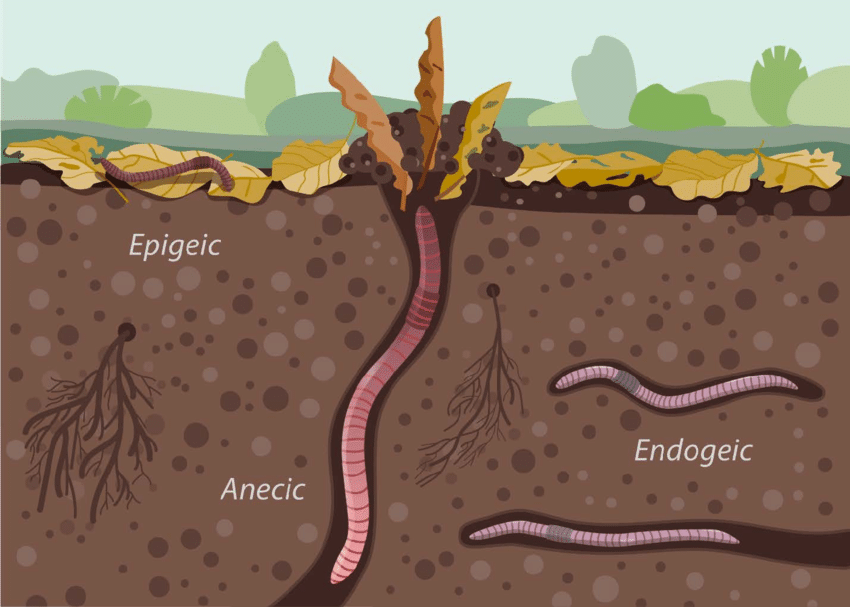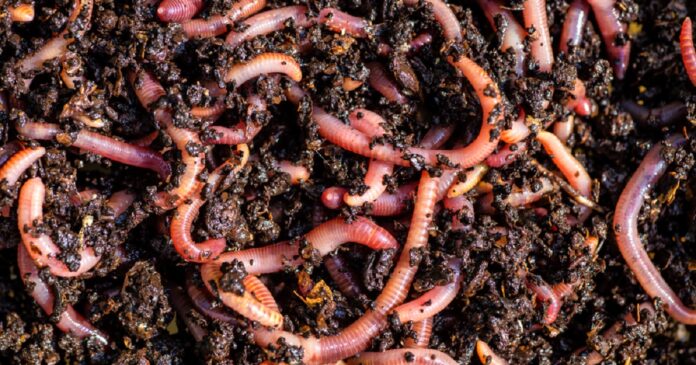Earthworms are soil builders. Their activities in the soil, add many immense benefits like enhancement of soil structure, nutrient increase, better drainage, and much more. Read on to know more about earthworm benefits to the soil.
First, let’s look at the types.
Types of Earthworms
There are three (3) ecological categories of earthworms – epigeic, anecic, and endogeic. The categorization is based on the burrowing and feeding behaviors of various species.
Anecic
Anecic (means “up from the earth” or “out of the earth” in Greek), is the class of earthworms dominant in soils in the temperate regions. They burrow vertically in the soil and feed on litter on the surface of the soil. They also often produce characteristic surface features called “middens” which are circular “mound-shaped” regions around the surface of the burrow’s opening.. The feeding and casting habits of anecic may affect soil characteristics up to >1m depth. Examples of Anecic earthworms are Lumbricus terrestris, Apporectodea longa. (Source: www.mscwbif.org)
Epigeic
Epigeic (which means “upon the earth” in Greek) species live in, consume, comminute and partially digest surface litter, rarely ingesting soil particles. Their mode of litter processing in natural systems results in greater nutrient leaching into the soil. Since epigeic feeds purely on litter and generally have a short gut transit time they probably depend on a rapid response of gut microbes to aid in digestion. Epigeic earthworm guts preferentially stimulate some microorganisms, as a result, reduce others leading to a relative dominance of microorganisms different to that found in uningested soils. Examples include Dendrobaena octaedra, D. attemsi, D. rubidus, Eiseniella tetraedra, Heliodrilus oculatus and Lumbricus rubellus. (Source: www.mscwbif.org)
Endogeic
Endogeics (which means “within the earth” in Greek) are the most prevalent earthworms (in biomass) in most tropical environments (Lavelle 1983) often being the only group present, particularly in agroecosystems. Endogeic are geophagous earthworms that feed on subsurface soil horizons and on soil OM of different qualities. They also, produce surface and below-ground casts of two main types: globular (compact, large) and granular (loose, small). Furthermore, endogeic casts, with generally more clay and frequently more OM than uningested soil, contain and release significant amounts of nutrients and NH4 (Barois et al., 1999) than uningested soil. Examples are Allolobophora chlorotica, Apporectodea caliginosa, A. icterica, A.rosea, Murchieona muldali, Pontoscolex corethrurus and Lampito mauritii. (Source: www.mscwbif.org)

Earthworm benefits
- Soil Nutrient availability
Earthworms feed on dead roots, leaves and grasses, soil, and other debris. They digest these materials and reintroduce them into the soil in their casts. Their casts are rich in soil nutrients and readily available for plant use. The bodies of worms decompose rapidly when they die and increase the nitrogen content of the soil. Worms casts are rich in phosphorus contributing about 4 times the content in the surface soil. Their feeding activity also helps to bring to the top leached soil nutrients and make them available for plant use.
Read also: 10 Simple and Easy Soil Tests
- Water and Air movement
Earthworms burrow through the soil and create channels that help in air and water movement in the soil. Soils with earthworms have improved drainage than those without earthworms. Worms population is high in no-till soils and therefore has about 6 times greater water infiltration than cultivated soils.
Read also: Do not Slash and Burn : 5 reasons why you shouldn’t
- Soil structure
The casts of earthworms are able to bind soil particles together into aggregates. These aggregates are able to store moisture without dispersing. Moreover, according to research, the casts of earthworms can rebuild topsoil. In favourable conditions, they can bring up about 50 t/ha annually, enough to form a layer 5 mm deep. One trial found worms built 18 cm thick topsoil in 30 years (www.dpi.nsw.gov.au). Moreover, they are able to break the hardpan to make way for roots.
Read also: 6 Soil Problems and Solutions
- Soil productivity
Worms break down residue and release essential soil nutrients. Their casts bind loose soil particles and increase water retention. Their activities create spaces that allow water and air movement. Altogether, these factors add up to make the soil more productive. Research into earthworms in New Zealand and Tasmania found earthworms introduced to worm-free perennial pastures produced an initial increase of 70–80% in pasture growth, with a long-term 25% increase. This raised stock carrying capacity (www.dpi.nsw.gov.au).
References:
How earthworms can help your soil (www.dpi.nsw.gov.au)
Types of earthworms (www.mscwbif.org)


